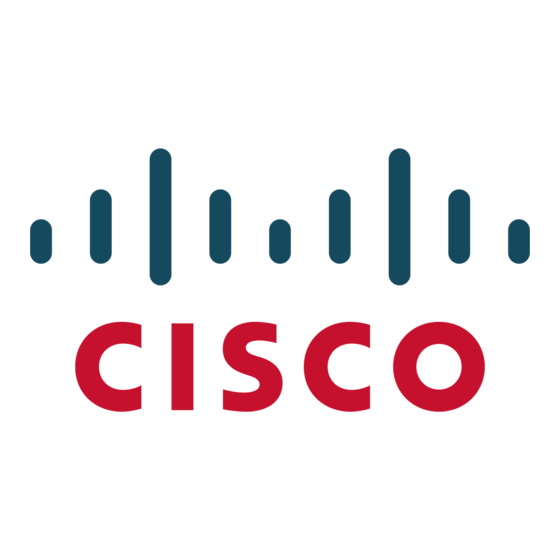Advertisement
Quick Links
Download this manual
See also:
User Manual
Cisco 1861 and Cisco 2800, 3800, 2900, 3900,
and 3900E Series Integrated Services Router
Interoperability with Cisco Unified Communications
Manager
®
Cisco
Services Routers can be deployed as unified communications routers as part of the
Cisco Unified Communications and Collaboration Solution. New and existing
deployments can benefit by using any of these routers as unified communications
gateways with Cisco Unified Communications Manager.
Cisco 1861 and Cisco 2800, 3800, 2900, 3900, and 3900E Series unified communications routers communicate
directly with Cisco Unified Communications Manager, allowing for the deployment of unified communications
solutions that are ideal for small and medium-sized businesses, large enterprises, and service providers that offer
managed network services. The Cisco 1861 and Cisco 2800, 3800, 2900, 3900, and 3900E Series Routers provide
a highly flexible and scalable solution for small and medium-sized branch and regional offices.
The Cisco 1861 and Cisco 2800, 3800, 2900, 3900, and 3900E Series unified communications routers support a
wide range of packet telephony-based voice interfaces and signaling protocols within the industry, providing
connectivity support for more than 90 percent of the world's private branch exchanges (PBXs) and public-switched-
telephone-network (PSTN) connection points. Signaling support includes T1/E1 Primary Rate Interface (PRI), T1
channel associated signaling (CAS), E1-R2, T1/E1 QSIG protocol, T1 Feature Group D (FGD), Basic Rate
Interface (BRI), foreign exchange office (FXO), ear and mouth (E&M), and foreign exchange station (FXS). You
can configure these unified communications routers to support from 2 to 720 voice channels. Additionally, you can
use these unified communications routers to terminate Session Initiation Protocol (SIP) trunking into the enterprise
or branch office by enabling the Cisco Unified Border Element features. Additional details are available in the Cisco
Unified Border Element data sheet.
As your enterprise seeks to deploy an expanding list of unified communications applications and services, Cisco
1861 and Cisco 2800, 3800, 2900, 3900, and 3900E Series unified communications routers - interoperating with
Cisco Unified Communications Manager - can provide a solution that will grow with your changing needs.
Interoperability Using SIP, H.323, or MGCP
The unified communications routers can communicate with the Cisco Unified Communications Manager using
Session Initiation Protocol (SIP), H.323, or Media Gateway Control Protocol (MGCP):
●
In SIP and H.323 mode, the unified communications routers communicate with Cisco Unified
Communications Manager as intelligent gateway devices.
●
In MGCP mode, these routers operate as stateless clients, giving Cisco Unified Communications Manager
full control. Dial plans are configured centrally in Cisco Unified Communications Manager. Then you can
automatically configure voice-gateway routers by downloading XML files.
© 2013 Cisco and/or its affiliates. All rights reserved. This document is Cisco Public Information.
1861 and Cisco 2800, 3800, 2900, 3900, and 3900E Series Integrated
Data Sheet
Page 1 of 20
Advertisement

Summarization of Contents
Cisco UC Router Interoperability and Migration
Interoperability Using SIP, H.323, or MGCP
Routers communicate with CUCM via SIP, H.323, or MGCP protocols for UC solutions.
IP Telephony Phased Migration
Routers facilitate gradual migration from circuit-switched to IP telephony for UC solutions.
UC Router Deployment and Capabilities
Centralized Call Processing
Centralized call processing model for easier management, lower TCO, and faster deployment.
Survivable Remote Site Telephony
SRST provides call-processing backup for remote sites during CUCM connectivity loss.
Cisco Unified Communications Router Features and Benefits
Overview of simple administration, scalability, and availability features for UC routers.
UC Router System Requirements and Performance
Scalability
Routers support enterprise needs from small offices to large corporations, scaling to 30,000 users.
Investment Protection
Modular platform design allows increasing voice capacity and leveraging existing investments.
Unified Communications Router with Cisco Unified Communications Manager Feature Summary
Summary of UC router features with CUCM, detailing protocol support.
Cisco Unified Communications Routers Minimum System Requirements Using SIP
Minimum system requirements for UC routers with CUCM, specifically for SIP protocol.
Cisco Unified Communications Routers Minimum System Requirements Using H.323
Minimum system requirements for UC routers with CUCM, specifically for H.323 protocol.
Cisco Unified Communications Routers Minimum System Requirements Using MGCP
Minimum system requirements for UC routers with CUCM, specifically for MGCP protocol.
Cisco Unified Communications Routers Minimum System Requirements for Conferencing, Transcoding, and Media Termination Point
Minimum system requirements for UC routers with CUCM for conferencing and media features.
Maximum Physical DS-0 Connectivity on Cisco Unified Communications Routers
Table detailing the maximum physical DS-0 connectivity supported by various Cisco UC routers.
CPU Performance on Cisco Unified Communications Routers
Table showing CPU performance metrics, specifically maximum simultaneous VoIP calls.
End-of-Sale Platforms: System Requirements and Connectivity
System requirements and connectivity data for end-of-sale UC routers.














Need help?
Do you have a question about the 3900E Series and is the answer not in the manual?
Questions and answers